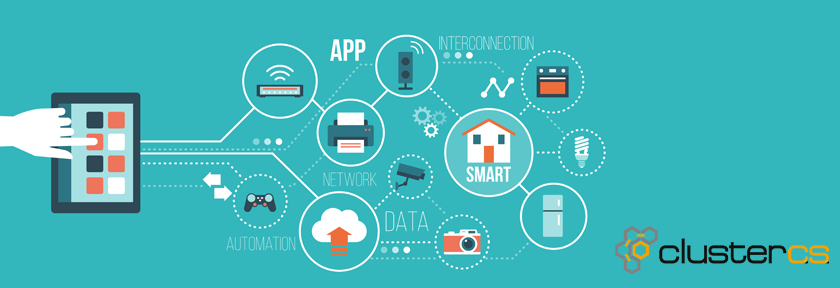It’s #backtoschool time! You might be well over the age of shopping for pencils and cute notebooks, but learning is a lifelong endeavor, especially for web developers, sysadmins, all types of programmers and online business owners.
Let’s see what the top 10 web development trends in 2017 are and how you can incorporate them in your projects.
10. INTERNET OF THINGS (IOT)
First of all, whether it’s coming down from marketing or your CEO fell in love with his smart speaker, there’s no escaping it. Chances are, if you’re a web developer, you will work on an IoT application this year. If not, you’ll at least research the area.
Smart houses are not a new trend and there are more and more devices capable of making our lives easier by connecting to the internet. They collect our data and interpret it. Even Roomba had plans to upload maps of users’ houses for gaining useful stats. It is a scary concept, one that was quickly scrapped after public out roar.
2017 and beyond will be all about making average devices smart and connecting the with each other.
9. VIRTUAL REALITY WEBSITE APPS
Virtual reality is not just confined to video games with Oculus Rift and HTC Vive, or YouTube 360 videos with Cardboard. The technology is here to stay and its applications are boundless, especially with the efforts coming from Google and Mozilla. Both companies are working on APIs to help VR make the transition to web. Towards the end of 2017 and early 2018 we could be seeing plenty of virtual real estate tours, premium news coverage and more.
8. ARTIFICIAL INTELLIGENCE FOR WEBSITE CREATION
2016 was the year where everyone talked about Google DeepMind and most of us changed our profile pictures to trippy, colorful and somewhat creepy images created by it. In 2017, AlphaGo, a program built by Google DeepMind, was the first one in history to beat a professional Go Player.
Right now, tech giants like Google, Facebook and Microsoft are releasing AI technologies to the public. There are also new players, especially in the website creation area. For example, The Grid offers Molly, an AI web designer that can automatically create a website for you after asking a few questions. Input your answers on branding, colors, layout and content, and Molly will create your website. Nifty, right?
7. CONVERSATIONAL USER INTERFACES / CHAT BOTS
Speaking of speaking with computers, chat bots and conversational user interfaces are huge right now. You probably noticed that Facebook pages now have bots asking you specifically what you want to purchase. It’s a huge first step towards widespread chat bots usage.
Web developers and, in general, anyone trying their hand at building a website, have plenty of tools to transform that website into a conversational user interface. Landbot.io is a fast, easy way of turning a landing page into a chat bot. It’s an interesting toy for a web developer. It’s also a valuable resource for an online marketer always looking for leads. Say goodbye to email forms. Let the users say hello to you and leave their email address without pestering them with call-to-actions!
6. STATIC SITE GENERATION
Static site generators are one of the biggest web development trends. Platforms like Jekyll will become more commonplace. A static website built by a generator offers advantages like increased speed, security and ease of deployment, while also offering a high resistance to huge amounts of traffic. Their downside is, of course, the fact that they cannot offer real time or user content such as comments. These aspects are essential in today’s landscape. However, if all you need is an online portfolio, a static site generator can be your tool.
5. BROWSER BASED CACHING
As you’ll see in the following top 10 web development trends entries, the whole digital landscape is tilting towards heavy multimedia use. The ever-expanding video content flooding the Internet and huge image databases or audio streams all add up to this. Developers need to find ways to speed up website loading times. We covered using Nginx to speed up your WordPress blog and we’re specialists at clustering, but we felt the need to mention browser based caching. More and more web developers are choosing browser based cache as a valuable tool to reduce network loads and load pages faster.
4. JAVASCRIPT AS TOP CHOICE FOR FULL STACK DEVS
JavaScript remains one of the top choices for full stack developers around the world. It’s also gaining ground. According to the yearly Stackoverflow survey results, JavaScript favorite technology among new and veteran developers. Around 60% of the 36.000 respondents named JavaScript as their favorite technology, followed by 51% for SQL or 30% for PHP. Especially relevant is Angular and its newly redesigned JavaScript framework – it’s easy to see why so many devs love it.
3. MOTION UI
Starting from 2016, Motion UI has gained ground and offered flexible CSS patterns and more. With Javascript libraries enabling the seamless integration of animations into websites and transition classes, Motion UI is turning more and more sites into dynamic, reactive experiences that charm users. In the 2017 landscape, it’s one of the biggest web development trends.
2. MODULAR DESIGN
In websites like Waaark, Motion UI ties nicely with modular design, a trend that’s been around since 2015. Because clean, well divided sites with elegant animations and responsive design keep visitors interested.
1. RESPONSIVE DESIGN
And yes, responsive design is the biggest web development trend in 2017, just like the year before.
In November 2016, mobile traffic surpassed desktop traffic for the first time. Moreover, this tendency will not have a roll back. Marketers around the world report higher conversion rates on mobile. Users spend more and more time on desktop devices, so web developers must create websites according to those market demands.
How about you? What web development trends are you most excited about and what tools do you use as a web developer? Let’s start the talk in the comments below.
